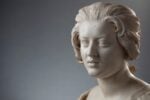Heads
.jpg)
Scandagliando una condizione umana, tutti abbandonano l’esercizio, andando in cerca, piuttosto, già di un tutto che si dischiuda lì, in una composizione apparentemente piccola, fatta di lineamenti, segni, tratti somatici distintivi oppure vaghi, identità rivelate o nascoste. Esistenze o, molto più semplicemente, teste.
Comunicato stampa
Ritratti, teste di vecchi, di donne, di ignoti. Autoritratti, volti di star e di amici, lineamenti evanescenti, teste scomparse e teste mancanti. Teste.
Nel corso della storia dell’arte, la testa ha accentrato pensieri e attenzioni di maniacali ed esperti ritrattisti, per lo più in cerca di una fedele somiglianza al vero. Infatti, nel tentativo o nella tentazione di ergersi a nuovi creatori della “real persona”, molti speravano e alcuni riuscivano, di suscitarne una ancor più vera, ispezionando l’anima del soggetto, fino a legarla indissolubilmente alla sua effige. Sventurato fu Dorian Gray.
Altrettanto numerose sono le testimonianze pittoriche di teste che non necessariamente ambivano a essere carta d’identità di un soggetto, ma che primariamente fungevano da studi per composizioni più complesse oppure esercitazioni fini a se stesse, utili ad affinare la mano nella messa a punto di uno sguardo, dei capelli, di un orecchio. Teste che partorirono numerose altre identità, reali o fittizie.
Rubens, tra i tanti, era solito eseguirne innumerevoli esemplari: teste di fronte, di profilo, singole o a coppie, come sperimentazioni in funzione dei suoi quadri o come guida per tutta la bottega. Molte sono le teste di vecchio dipinte dal Tiepolo, pensanti e meditative, quasi a suggerire l’eterna magnificenza dei grandi pensatori della storia. Mistero e grazia sono celebrati nelle teste di donne e di fanciulle, da Leonardo Da Vinci a Renoir. Di morte e crudeltà sono monito quelle di Géricault. Malinconiche e innumerevoli, quelle di Van Gogh, che sembra incontrarle tutte alla fine del giorno, di ritorno dai campi, illuminate dalla luce calda di una candela accesa, ultimo ristoro dopo le fatiche di un’intera giornata. E ancora: teste per mano di Paolo Uccello, di Dürer, di Rembrandt, di Modigliani, di Malevič, di Dalì, di Picasso...
Teste “vere” eppur ignote. Introspezioni psicologiche, non si sa bene di chi: di qualcuno, di uno, di nessuno… Certo dell’uomo, dell’Homo Sapiens.
Mai come nella specie umana, la testa rappresenta il bene più prezioso, custode del pensiero, cammeo dell’intera persona, vanto della propria personalità, specchio o, meglio, superficie di una vita profonda come un pozzo, i cui riverberi affiorano in alto, tra le increspature, la pienezza e gli spigoli.
Il volto, incorniciato nel capo, diventa allora meridiana di un tempo che è giudice e tiranno per tutti, promemoria di una vita splendida e mortale. Speranze affiorano luminose sugli incarnati e fantasmi si annidano nei solchi scavati dai giorni e dalle emozioni.
In questa prospettiva, secondo queste e altre aspirazioni, si collocano le teste dipinte da sedici pittori contemporanei, invitati a confrontarsi sul tema. Alla ricerca di se stessi, di un’infanzia creativa mai perduta, del mistero di uno sguardo adorno di tradizioni e mitologie, di tracce e rimasugli di quello che poteva essere e non è più, essi mandano in scena storie, citazioni, evocazioni, memoriali e oblio. Scandagliando una condizione umana, tutti abbandonano l’esercizio, andando in cerca, piuttosto, già di un tutto che si dischiuda lì, in una composizione apparentemente piccola, fatta di lineamenti, segni, tratti somatici distintivi oppure vaghi, identità rivelate o nascoste. Esistenze o, molto più semplicemente, teste.
Vera Portatadino
www.yellowspace.jimdo.com
Portraits, heads of old men, of women and of unknown figures. Self-portraits, the faces of stars and of friends, fleeting traces, heads vanished and heads missing. Heads.
Throughout art history, the head has brought together the thoughts and attention of obsessive and expert portraitists, largely seeking a faithful likeness to the original. In fact, in the attempt or temptation to stand as new creators of the ‘real person’, many hoped (and some managed) to arouse an even more truthful one, drawing out the very soul of the subject, to the point of binding it indissolubly to its effigy. Dorian Gray was out of luck.
Just as numerous are the painterly testimonies of heads that did not necessarily aim to become the identity card of a subject, yet which served primarily as studies for more complex compositions, or which were exercises, ends unto themselves, useful for honing ability of the hand to capture a gaze, hair or an ear. Heads which gave rise to a host of other identities, be they real or fictitious.
Rubens, like many other painters, would carry out countless exemplars: heads from the front, from the side, single or in couples, as experiments for his paintings or as a guide for his whole workshop. There are many heads of an old man painted by Tiepolo, ponderous and meditative, as if hinting at the eternal magnificence of the great thinkers of history. Mystery and grace are celebrated in the heads of women and girls, from Leonardo Da Vinci to Renoir. Those by Gericault are forewarnings of death and cruelty. Van Gogh’s are melancholic and so numerous when he encounters them all at the end of the day, on their way back from the fields, lit up by warm candlelight, the last respite after a day’s toil. And so on: heads by Paolo Uccello, Dürer, Rembrandt, Modigliani, Malevič, Dalì, Picasso...
And ‘real’ heads, despite being unknown. Psychological introspection, but we don’t know of whom: of someone, of one, of no one… Why of course: of man, of the Homo Sapiens.
Nowhere like in the human race does the head represent the most precious of assets, the stronghold of thought, the summary of the entire person, pride of his/her own personality, mirror, or rather, surface of a life as deep as a well, the ripples of which come out at the top, among the wrinkles, fullness and edges.
The face, framed by the head, thus becomes the meridian of the passing of time, which is the judge and tyrant of us all, the reminder of a splendidly mortal existence. Hopes surface brightly on the flesh, and ghosts of the past lurk among the furrows dug out by the passing of days and emotions.
On the basis of these and other aspirations, it is in this perspective that the heads painted by the 16 contemporary painters invited to address the theme are positioned. In search of themselves, of a creative childhood which never left them, of the mystery of a gaze laden with traditions and mythologies, with traces and leftovers of that which could have been and no longer is, they stage stories, citations, evocations, memorials and oblivion. Fathoming a very human condition, they all abandon the exercise, preferring to go off in search of an everything which opens there, in an apparently small composition, made up of lines, signs, distinctive or vague facial features, up-front or hidden identities. Existences or, much more simply, heads.



